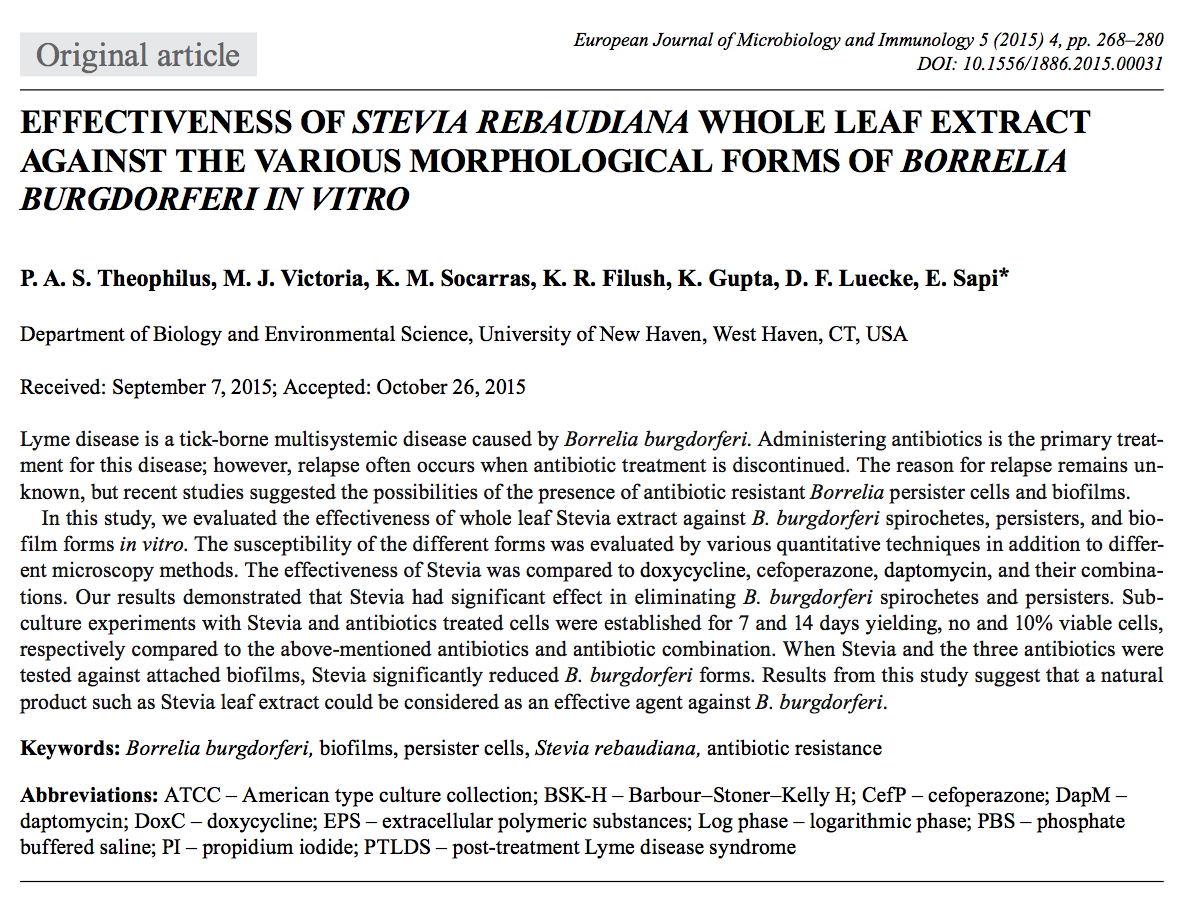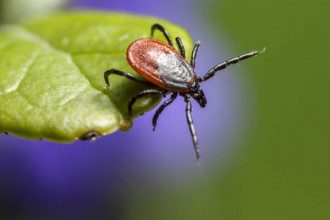By Sayer Ji
Contributing Writer for Wake Up World
Lyme disease is exceedingly difficult to treat, due to its well-known shape-shifting (pleomorphic) abilities, with conventional antibiotics often failing to produce a long-term cure. Could the commonly used natural plant Stevia provide a safer, and more effective means to combat this increasingly prevalent infection?
A promising new preclinical study has revealed that whole stevia leaf extract possesses exceptional antibiotic activity against the exceedingly difficult to treat pathogen Borrelia Burgdorferi known to cause Lyme disease. The study found, “Stevia whole leaf extract, as an individual agent, was effective against all known morphological forms of B. burgdorferi.”
At present, the CDC acknowledges that at least 300,000 are infected with Lyme disease, annually, with the conventional standard of care relying on antibiotics that are not only toxic but increasingly coming under scrutiny for addressing only surface aspects of the infection, often leaving antibiotic-resistance Lyme disease deep within the system to continue to cause harm.
B. burgdorferi has a complex life cycle, and can exist in radically different forms: spirochetes, spheroplast (or L-form which lacks a cell wall), round bodies or cyst form (which allows for dormancy and escaping PCR detection), and highly antibiotic-resistant biofilms. This pleomorphic property makes conventional treatment exceptionally difficult because while some conventional antibiotics are effective against forms with a cell wall such as spirochetes, they are ineffective against those without a cell wall. This enables B. burgdorferi to change form to evade eradication through conventional means. Also, biofilm formation creates a significant barrier against most conventional antibiotics, even when used in combination, and has been recently suggested to be the most effective mechanism of resistance.
The new study was published in the European Journal of Microbiology & Immunology and titled, “Effectiveness of Stevia Rebaudiana Whole Leaf Extract Against the Various Morphological Forms of Borrelia Burgdorferi in Vitro,” and conducted by researchers from the Department of Biology and Environmental Science, University of New Haven, West Haven, CT.
The researchers directly compared an alcohol extract of a whole stevia leaf product commonly found on the U.S. retail market to conventional antibiotics, and assessed their respective abilities to kill the various forms of Borrelia burgdorferi, including so called “persister” forms.
The study pointed out that, according to the CDC, about 10-20% of Lyme disease patients treated with antibiotics for the recommended 2-4 weeks experience adverse health effects, such as fatigue, pain, or joint and muscle aches. In some of these patients, the adverse effects last for more than 6 months. These patients are often labeled with “chronic Lyme disease,” or “post treatment Lyme disease syndrome.” While the adverse effects of antibiotics, including their destruction of beneficial microbes in the gut, may account for this syndrome, another possibility is that the drugs drive antibiotic-resistant forms of the disease deeper into the system, resulting in enhanced disease-associated malaise.

Given the well-known challenges of eradicating B. burgdorferi through conventional antibiotics, the researchers explored the potential for stevia as an antimicrobial.
Stevia is not normally considered an anti-microbial agent, but all plants possess in-built phytochemical defense systems which protect them against infection, and which by consuming them, we ourselves can sometimes harness and benefit from. The researchers elaborate on this point:
The leaf extract of Stevia possesses many phytochemicals, which include austroinullin, ?-carotene, dulcoside, nilacin, rebaudi oxides, riboflavin, steviol, stevioside, and tiamin with known antimicrobial properties against many pathogens [40, 42, 43]. The role of these compounds is mainly to protect the plant from microbial infection and adverse environmental conditions [38–43].
The researchers explored Stevia’s potential effectiveness against B. burgdorferi cultures, comparing it to three common antibiotics sometimes used to treat Lyme’s disease: doxycycline, cefoperazone, daptomycin, as well as their combination.
The study results were summarized as follows:
The susceptibility of the different forms was evaluated by various quantitative techniques in addition to different microscopy methods. The effectiveness of Stevia was compared to doxycycline, cefoperazone, daptomycin, and their combinations. Our results demonstrated that Stevia had significant effect in eliminating B. burgdorferi spirochetes and persisters. Sub-culture experiments with Stevia and antibiotics treated cells were established for 7 and 14 days yielding, no and 10% viable cells, respectively compared to the above-mentioned antibiotics and antibiotic combination. When Stevia and the three antibiotics were tested against attached biofilms, Stevia significantly reduced B. burgdorferi forms. Results from this study suggest that a natural product such as Stevia leaf extract could be considered as an effective agent against B. burgdorferi.
Notably, the study found that the most antibiotic resistant form of B. burgdorferi, the biofilm form,actually increased in mass when individual antibiotics were administered. Stevia, on the other hand, reduced the biofilm mass on both tested surfaces (plastic and collagen) by about 40%.
It is also interesting to note that the stevoside extract, by itself, was not found to be an effective antimicrobial agent against B. burgdorferi; nor did it have any effect on resistant cells. Mass market stevia products, including Coca-cola’s Truvia (ironic branding, considering it does not have the truly therapeutic property of whole stevia), would not, therefore, have the medicinal property associated with the whole herb extract. This speaks, of course, to the well known principle in natural medicine that the activity of the whole can not be reproduced through a part, nor is the therapeutic activity of the whole identical to that of the sum of its parts.
While this is only a preliminary study and should not be interpreted to mean the consumption of whole stevia extract will result in clinical improvements comparable or superior to conventional antibiotics, it opens the door to future research on the topic. That said, anyone who is considering natural ways to prevent Lyme’s disease infection, or to support as an adjunct therapy conventional treatments of the disease, could utilize this safe, food-based substance as a potential means of support and synergy. Certainly, there is little if any indication that stevia could cause harm, unlike conventional treatments. See our stevia research section here for more information.
For more research on natural interventions for Lyme’s disease visit our research page on the topic: Lyme disease research.
Recommended articles by Sayer Ji:
- Better Than Chemo: Turmeric Kills Cancer Not Patients
- Mammography Is Harmful and Should Be Abandoned, Scientific Review Concludes
- Cinnamon May Be Superior to Ibuprofen for Menstrual Pain, Study Reveals
- “Killer Germs” Obliterated by Medicinal Smoke Smudging, Study Reveals
- Coconut Water: A New Alzheimer’s Disease Treatment?
- Turmeric’s ‘Smart Kill’ Properties Put Chemo & Radiation To Shame
- 6 Evidence-Based Ways Drumming Heals Body, Mind and Soul
- Tylenol Kills Emotions As Well As Pain, Study Reveals
- Research: Plants Cure Cancer, Not Chemicals
- Beet Juice Boosts Cognitive Function In One Dose
- 13 Evidence-Based Medicinal Properties of Coconut Oil
- 25 Cancer Stem-Cell Killing Foods That Are Smarter Than Chemo and Radiation
About the author:
Sayer Ji is on the Board of Governors for the National Health Federation and Fearless Parent, Steering Committee Member of the Global GMO Free Coalition (GGFC), a reviewer at the International Journal of Human Nutrition and Functional Medicine, and founder of GreenMedInfo.com – an open access, evidence-based resource supporting natural and integrative modalities.
In 1995 Sayer received a BA degree in Philosophy from Rutgers University, where he studied under the American philosopher Dr. Bruce W. Wilshire, with a focus on the philosophy of science. In 1996, following residency at the Zen Mountain Monastery in upstate New York, he embarked on a 5 year journey of service as a counsellor-teacher and wilderness therapy specialist for various organizations that serve underprivileged and/or adjudicated populations. Since 2003, Sayer has served as a patient advocate and an educator and consultant for the natural health and wellness field.
Visit GreenMedInfo online and on Facebook, or sign up for GreenMedInfo’s e-Newsletter.

If you've ever found value in our articles, we'd greatly appreciate your support by purchasing Mindful Meditation Techniques for Kids - A Practical Guide for Adults to Empower Kids with the Gift of Inner Peace and Resilience for Life.
In the spirit of mindfulness, we encourage you to choose the paperback version. Delve into its pages away from screen glare and notifications, allowing yourself to fully immerse in the transformative practices within. The physical book enriches the learning process and serves as a tangible commitment to mindfulness, easily shared among family and friends.
Over the past few years, Wake Up World has faced significant online censorship, impacting our financial ability to stay online. Instead of soliciting donations, we're exploring win-win solutions with our readers to remain financially viable. Moving into book publishing, we hope to secure ongoing funds to continue our mission. With over 8,500 articles published in the past 13 years, we are committed to keeping our content free and accessible to everyone, without resorting to a paywall.








